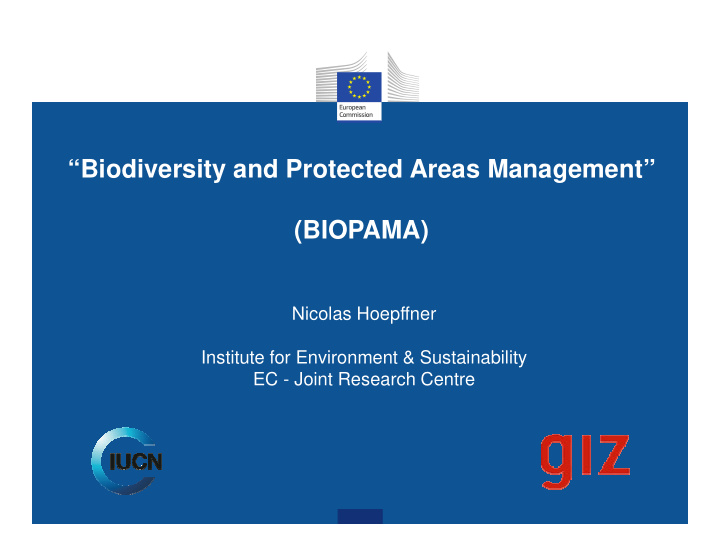



“Biodiversity and Protected Areas Management” (BIOPAMA) Nicolas Hoepffner Institute for Environment & Sustainability EC - Joint Research Centre
������� �� �������������������������� �� �������������������������� �� ������������������������������ � ���������������������� � ��������������� � �� ��!����������� ��"�#����������$$ ��������% � �����&������ '������������"�����$��
1. JRC presentation Joint Research Centre The European Commission’s in-house science service ��������������������� ��������������������� Serving society Stimulating innovation Supporting legislation
1. JRC presentation ����������������������������� JRC is the European Commission’s in-house science service. It provides the science for policy decisions, with a view to ensuring that the EU achieves its Europe with a view to ensuring that the EU achieves its Europe 2020 goals for a productive economy as well as a safe, secure and sustainable future. The JRC plays a key role in the European Research Area and reinforces its multi-disciplinarity by networking extensively with leading scientific organisations in the Member States, Associated Countries and worldwide.
1. JRC presentation � ���������������� � ��������������������� � (���������������)����������*���� �+��� ,���+� • ������������������� 8 ������ ��� -������+�.���/����� ����+�&$��� � �+0')�$����������������$����������������1�1 • ���� 8 -�� +��� ,��� � �+�20������������$�� �������������1�1 � ������������������������������� ������������������ � ��)����������������$$�����������34�$� ���5 • �� 8 9�� �����+�-�������������$��+���� � ��!�������� � � ��������������.������������3 ������ � ���,��*�6�)7��� ��������� �+�$ ���67�� �� ����������������� • �� 8 ������+�.���/����� �����������$��+���� � • �� 8 ������+�.���/����� �����������$��+���� � � ��������������3���,� • �!�� 8 ��$��+���� � � ���������������������������������&�������� �����������:�� • ��� 8 ��$��+���� � � ��������������3�;�������������&��������� ��� • �"�! 8 ��$��+���� � � ��������������<�� �������������������������� • �!�� 8 &�;� �+�&$��� � ������������������$����;��.����� �,��� �&������
1. JRC presentation ��������������������� � 5 3���,� � 5 � ���������$��� � 5 3�;���������=�� ����������,�� � 5 �,���� �����=�>������������ � 5 �,���� �����=�>������������ � 5 <�� ���=����������$��������� � 5 &������������������+���� ����,���� ��� � 5 ������������������������������������ �,�
2. Introduction to BIOPAMA BIOPAMA: General Information Funded (10 th EDF) under EC/ Intra ACP Envelope for Biodiversity; thus the geographical focus limited to ACP Countries. to ACP Countries. 4-year Programme (2011-2015) recognizing Protected Areas as a key tool for in-situ conservation and for maintaining ecosystem services. It also recognizes challenges of biodiversity conservation in ACP countries.
2. Introduction to BIOPAMA Rational behind BIOPAMA CBD Strategic Plan 2011-2020 - Goal C: To improve the status of biodiversity by safeguarding ecosystems, species and genetic diversity Target 11 By 2020, at least 17% of terrestrial and inland water, and 10% of coastal and marine areas, especially areas of particular importance for biodiversity and ecosystem services, are conserved through effectively and equitably managed, ecologically representative and well connected systems of protected areas and other effective area-based conservation measures, and integrated into the wider landscapes and seascapes. (Also Targets 1, 2, 5, 6, 9, 12, 14, 15, 16, 17, 19)
2. Introduction to BIOPAMA General Objective : To improve long-term conservation of biodiversity in ACP regions and reduce the poverty of populations surrounding PAs. Specific objective: Specific objective: - Enhance existing institutions and networks, based on the best available science and knowledge , by building their capacity to strengthen policy and to implement well informed decisions on biodiversity conservation, protected areas management and Access and Benefit Sharing .
2. Introduction to BIOPAMA Structure of the Project Two main components: 1. The Protected Areas Component (support CBD Targets 1, 2, 11, 14, 17,19) : Result 1 - The effective planning/management of PAs is Result 1 - The effective planning/management of PAs is improved by using the best available scientific and policy information (JRC). Result 2 – Establishing a “Centre for PAs & Biodiversity” (Observatory) in each region and developing capacity building programmes (IUCN). 2. Access and Benefit Sharing (GIZ) support CBD Target 16
2. Introduction to BIOPAMA BIOPAMA main deliverables 1. Build a reliable reference information system of Protected Areas including information on: - biodiversity value and ecosystems behaviour - pressures and threats to species and PAs - - ecosystem services provided by PAs to local population. ecosystem services provided by PAs to local population. 2. Strengthen institutions and networks by building their capacity to implement well informed decisions on biodiversity conservation 3. Creation of a Regional “Observatory for Protected Areas and Biodiversity” in each of the 3 regions (Africa, Caribbean, Pacific).
3. JRC in BIOPAMA JRC contribution to BIOPAMA - Result 1 of the Protected Areas Component Specific objective “ Provide the right Information , in the right Way , to the right People with the right Tools . ” right People with the right Tools . ” This also implies that we need to “ Collect the right information from the right people with the right tools. ” Development of Data and Information Reference System for the Regional Observatories .
3. JRC in BIOPAMA previous achi evements • ������������������������������������������������ 2007 JRC developed a tool to assess and prioritize 741 Protected Areas in Africa according to biodiversity values and threats, using objective, continent-wide datasets ������������������������������������ �
3. JRC in BIOPAMA • previous achievements ���������������������������������������� 1) We need to go beyond the boundaries of Protected Areas (connectivity, fragmentation, new PAs are major issues) 2) Policy issues become more and more global and there is a need for accessible global reference data and information systems global reference data and information systems 3) Validation of information requires better means for capturing ground truth 4) Increase reusability of data, models and IT infrastructure for improved communication, validation and reduced maintenance costs 5) Repeated assessments possible only with reference material but also with automated data & models sharing
Recommend
More recommend